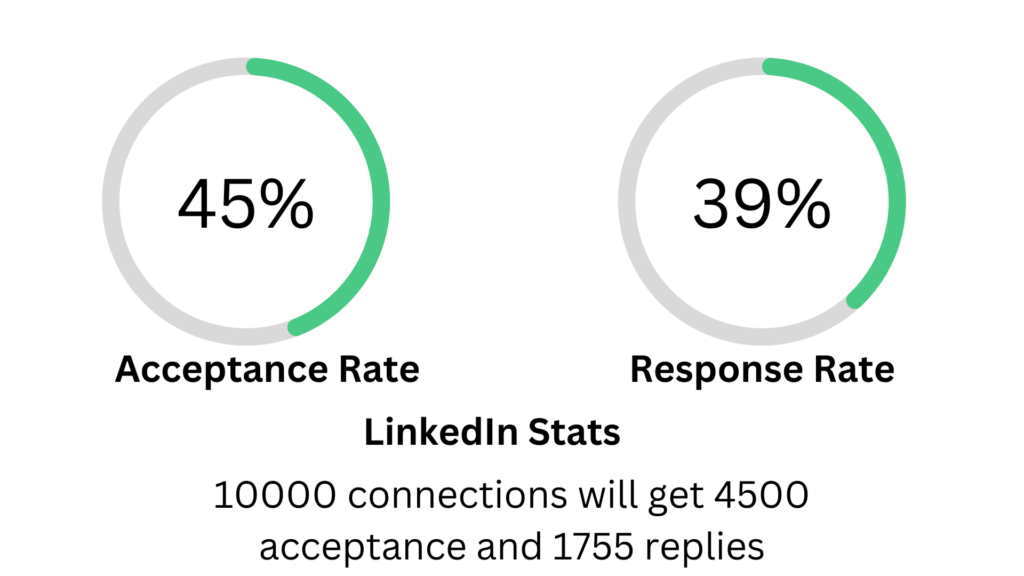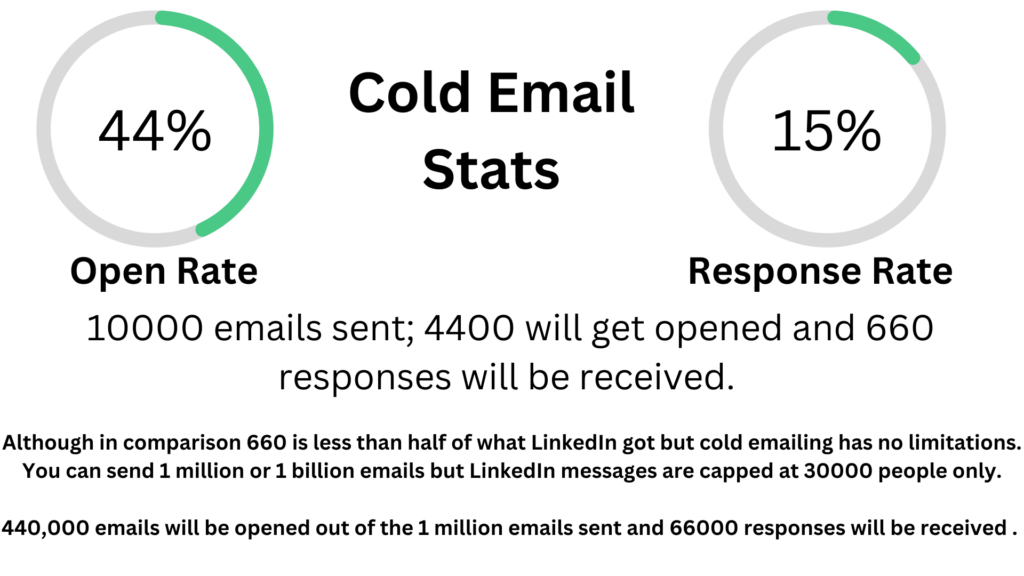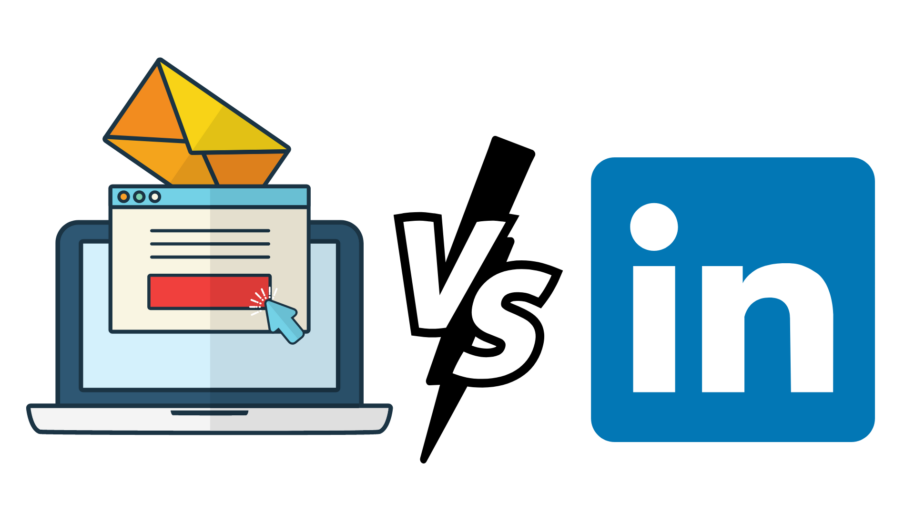When it came to cold outreach or lead creation, cold email had no alternatives until LinkedIn. In terms of reaching prospects formally online without being intrusive LinkedIn is without a doubt the cold email’s main rival. In this comparison, we are going to talk about Cold Email vs LinkedIn messages.
Let’s examine which is superior and in what ways. While LinkedIn may be superior in some ways, there are some instances where cold email wins out. Let’s investigate.
Table of contents
1. Which has more open and response rate ?
1.1 LinkedIn messages have a high open and response rate
1.2 Cold emails don’t produce a high open and response rate
2. Which has more reach ?
2.1 Cold emails have by far the bigger reach
2.2 LinkedIn messages have limited reach
3. Which has automation and scalability?
3.1 Cold emails are scalable and can be automated
3.2 LinkedIn messages cannot be automated hence not scalable
4. Which is affordable?
4.1 Cold email is free but can be paid for
4.2 LinkedIn too is free but premium features can help
5. Conclusion
Which has more open and response rate ?
LinkedIn messages have a high open and response rate
LinkedIn messages have a close to 100% open rate, but there is a catch. You must be connected to the client only then you can send them a direct message DM in their inbox. You can only send DMs to your 1st-degree connections only, not 2nd, not 3rd.
Linkedin is designed similarly to Facebook or Instagram, so when someone sends you a message, it appears in your inbox, just like a text message on your phone, and DMs in WhatsApp, Facebook, and Instagram.
According to Salesbread, LinkedIn messages have a 39% response rate, which they refer to as ‘LinkedIn Outreach.’

However, there is an important factor to consider here as well: the acceptance rate of 45%. So, even if you have 10000+ connections (which is a lot, as not many people have that many), 45% acceptance will result in 4500 people opening them and a 39% reply rate will result in 1755 replies.
Cold emails don’t produce a high open and response rate
The average open rate for cold emails is 44%.
Anyone with an email address is able to send a cold email to anyone. As observed in LinkedIn messaging, there is no need for connections.
At least once every day, businesses and employees check their work emails. People will open them if they have appropriate subject lines, personalization, and templates.
The average response rate for the cold email marketing is 15%. Do the math now.

Lets assume you sent 10,000 cold emails, 44% open rate will give 4400 openings and 660 replies, based on a 15% response rate.
Which has more reach?
Cold emails have by far the bigger reach
Reach is a significant factor that businesses must consider before conducting cold outreach.
Since there are 4 billion email accounts and you can send an email to any one of them, cold emails have the greatest reach.
There is no cap on the number of recipients or email addresses you can send emails to. Some might worry how come is it legal to send it to anyone in the world. Countries do have laws on it but yes they totally are legal.
Therefore, cold email emerges as the winner vs linkedin in terms of reach.
LinkedIn messages have limited reach
The reach of LinkedIn messages is probably one of their major drawbacks. Only your first-degree connections can send you messages.
LinkedIn has capped the number of first-degree connections you can have. LinkedIn allows you to only have 30000 first-degree contacts on LinkedIn.
Which, incidentally, only the top 1% may possess. One percent of those polled claimed to be Super Connectors with more than 10,000 connections.
Although 98% of Fortune 500 organisations utilise LinkedIn and 50% of members earn $75,000 or more annually, Having them or their employees as first-degree ties is extremely challenging.
Which has automation and scalability?
Cold emails are scalable and can be automated
The biggest advantage of using cold emails is that they are scalable. You may manually send cold emails, but automation is necessary if you want to expand and build your organisation.
There are softwares for cold emailing that send tens of thousands of emails with a single click. Gone are the days when you would send each email separately.
Now, with exciting subject lines, a little personalization, and carefully designed email templates, you can pitch to millions of prospects in a matter of minutes.
A single individual can send all the necessary cold emails to all the email addresses, negating the need to engage a sales crew.
LinkedIn messages cannot be automated hence not scalable
If you’re thinking about automating your LinkedIn messages, you should stop right now.
Linkedin does not allow its users to use automation tools to automate their messages. Crawlers and bots are also not permitted.
This can result in a permanent or temporary ban from LinkedIn.
As a result, the opportunity to grow and scale your business is not available due to the lack of automation.
Which is affordable?
Cold email is free but can be paid for
As long as you have a laptop computer or even a mobile phone, you can send emails to anyone in the world with an email address and an internet connection. In that regard, cold email is totally free.
However, as we previously stated, automation is necessary in order to scale your business. You must send numerous cold emails simultaneously in a short period of time to save time and effort.
There are businesses who offer paid services to accomplish just that. Some could be pricey, but others are affordable. Which company offers the greatest service at a reasonable cost is up to you to decide.
You must look out for softwares that are able to send large numbers of emails with personalised content, interesting subject lines, and email templates without having their emails discarded as spam.
LinkedIn too is free but premium features can help
On the other side, using LinkedIn is also cost-free. To your first-degree contacts, you can freely compose and send creative messages. But doing that won’t save you time or enable you to grow.
However, Linkedin has only very slightly increased its level of automation. Users are permitted to utilise LinkedIn’s own premium capabilities to send mass messages and its automation tools, provided that LinkedIn believes the messages were not created by bots, crawlers, or other entities that violate its data security.
There’s always a chance that automation programmes will act inconsistently with LinkedIn’s terms and regulations, which can result in your account being suspended.
Cold Email vs LinkedIn: Conclusion
We did our best to set the two apart based on general criteria that any sales representative ought to take into account. Which lead generation strategy you prefer is now up to you.
There is no denying that LinkedIn plays a significant role in lead generation.
But if we had to choose just one, cold email would win out due to its widespread usage and benefits. More reach, more automation, and greater scalability at roughly the same price, if not lower, is always preferable in our opinion.
Linkedin is great, but because of its limited options, it cannot scale. However, a sales representative needs to generate leads using LinkedIn and cold email. They work best together in a common mix and match to produce leads.
So who won according to you in cold email vs linkedin?
How can SafeMailer help you?
Your marketing emails will be sent out in waves using cold emailing software like SafeMailer which is free to start with.
Instead of sending 1,000 emails all at once, it sends them over several days, 1-2 minutes apart, much like a real human would, thus bypassing spam filters.


Leave a Reply